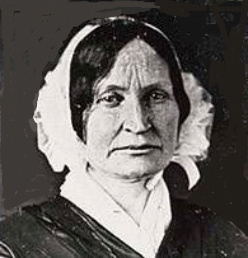Mary Lyon (Mary Lyon)

The daughter of a farming family in Buckland, Massachusetts, Mary Lyon had a hardscrabble childhood. Her father died when she was five, and the entire family pitched in to help run the farm. Lyon was thirteen when her mother remarried and moved away; she stayed behind in Buckland in order to keep the house for her brother Aaron, who took over the farm. She attended various district schools intermittently and, in 1814, began teaching in them as well. Lyon’s modest beginnings fostered her lifelong commitment to extending educational opportunities to girls from middling and poor backgrounds. Mary Lyon was eventually able to attend two secondary schools, Sanderson Academy in Ashfield and Byfield Seminary in eastern Massachusetts. At Byfield, she was befriended by the headmaster, Rev. Joseph Emerson, and his assistant, Zilpah Polly Grant. She also soaked up Byfield’s ethos of rigorous academic education infused with Christian commitment. Lyon then taught at several academies, including Sanderson, a small school of her own in Buckland, Adams Female Academy (run by Grant), and the Ipswich Female Seminary (also run by Grant). Lyon’s attendance at the then novel, popular, lectures in laboratory botany by Amos Eaton influenced her involvement in the female seminary movement. In 1834, Laban Wheaton and his daughter-in-law, Eliza Baylies Chapin Wheaton, called upon Mary Lyon for assistance in establishing the Wheaton Female Seminary (now Wheaton College) in Norton, Massachusetts. Miss Lyon created the first curriculum with the goal that it be equal in quality to those of men’s colleges. She also provided the first principal, Eunice Caldwell. Wheaton Female Seminary opened on 22 April 1835, with 50 students and three teachers. Mary Lyon and Eunice Caldwell left Wheaton, along with eight Wheaton students, to open Mount Holyoke Female Seminary.
During these early years, Mary Lyon gradually developed her vision for Mount Holyoke Female Seminary, which would resemble Grant’s schools in many respects but, Lyon hoped, draw its students from a wider socioeconomic range. The college was unique in that it was founded by people of modest means and served their daughters, rather than the children of the rich. She was especially influenced by Reverend Joseph Emerson, whose Discourse on Female Education (1822) advocated that women should be trained to be teachers rather than “to please the other sex.” Mount Holyoke opened in 1837: the seminary was ready for “the reception of scholars on November 8, 1837.” Lyon strove to maintain high academic standards: she set rigorous entrance exams and admitted “young ladies of an adult age, and mature character.” In keeping with her social vision, she limited the tuition to $60/year, about one-third the tuition that Grant charged at Ipswich Female Seminary, which was central to her mission of “appeal[ing] to the intelligence of all classes.” Mary Lyon, an early believer in the importance of daily exercise for women, required her students to “walk one mile (1.6 km) after breakfast. During New England’s cold and snowy winters, she reduced the requirement to 45 minutes. Calisthenics—a form of exercise—was taught by teachers in unheated hallways until a storage area was cleared for a gymnasium.
In order to keep costs low, Mary Lyon required students to perform domestic tasks—an early version of work/study. These tasks included preparing meals and washing floors and windows. Emily Dickinson, who attended the Seminary in 1847, was tasked with cleaning knives. Though Lyon’s policies were sometimes controversial, the seminary quickly attracted its target student body of 200. Mary Lyon died of erysipelas (possibly contracted from an ill student in her care) on March 5, 1849.
Born
- February, 28, 1797
- USA
- Buckland, Massachusetts
Died
- March, 03, 1849
- USA
- South Hadley, Massachusetts
Cause of Death
- erysipelas
Cemetery
- Mount Holyoke College Burial Site
- South Hadley, Massachusetts
- USA



